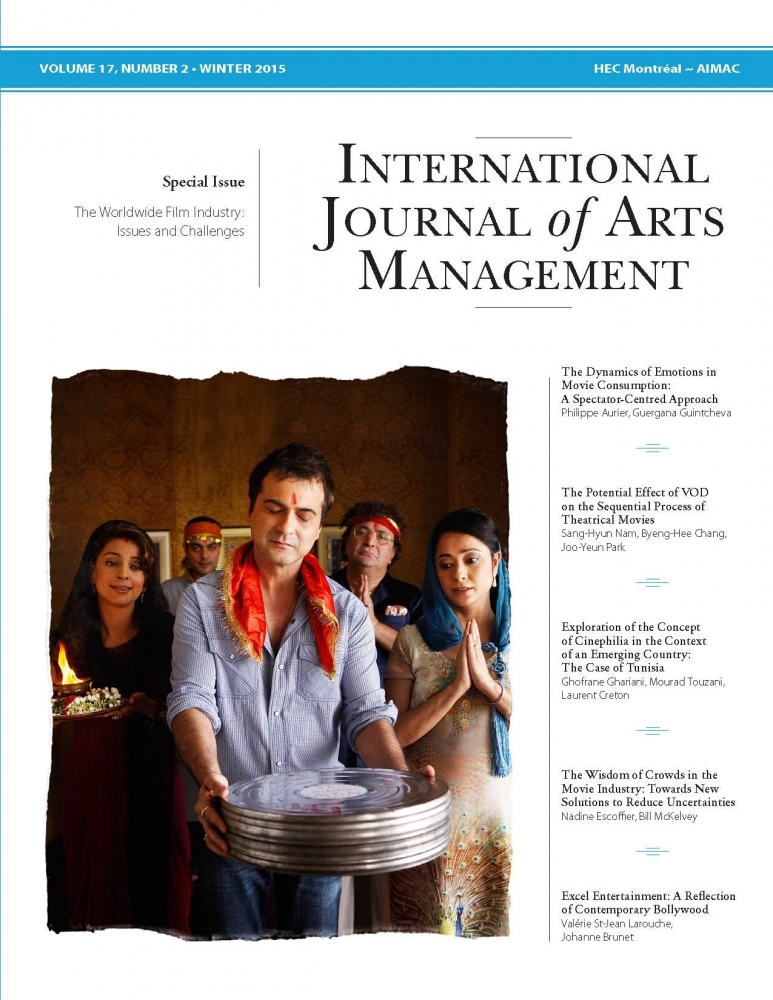IJAM Volume 17 Number 2 (PRINT)
Product: Journal
$84.00 CA
EDITORS’ NOTE
Dear Readers,
I leave it to our guest editors, Johanne Brunet and Renaud Legoux, to introduce this special issue dedicated to film. I thank both of these colleagues for their superb work in assembling this issue of the Journal.
As I sign off on this issue of IJAM, my main task is to inform you that this will be my last as editor. After four years at the helm of the editorial board, I have decided to take on new challenges and have accepted the position of Director of Sustainability at HEC Montréal.
I extend my heartfelt thanks to the editorial team of Antonella Carù, Ian Gilhespy, Philippe Ravanas and Zannie Voss, all of whom have made outstanding contributions to each issue of the Journal. I would also like to acknowledge the support of François Colbert and the excellent work of Louise St-Pierre and, more recently, Béatrice Mille in managing the publishing process with rigour and attention to aesthetics.
Finally, dear authors, it has been a pleasure to read you and to meet you and I hope to see you at future meetings of AIMAC.
Johanne Turbide
Editor
EDITOR’S NOTE GUEST
The Worldwide Film Industry: Issues and Challenges
We are very pleased to present this special issue of IJAM dedicated to the worldwide film industry. While global revenues will soon reach the $100 billion mark,* current business practices are being tested by changing consumer behaviour, technological developments and continually evolving local markets. To help all of us better understand this rapidly evolving environment, this special issue of the Journal offers five distinct views of the cinema industry and its challenges from a worldwide perspective.
In the first contribution, “The Dynamics of Emotions in Movie Consumption: A Spectator-Centred Approach,” Philippe Aurier and Guergana Guintcheva explore the emotional unfolding that is experienced through movie attendance. This fresh look at the experiential nature of cinema touches a definitional dimension of arts consumption.
Next, Sang-Hyun Nam, Byeng-Hee Chang and Joo-Yeun Park, in “The Potential Effect of VOD on the Sequential Process of Theatrical Movies,” take note of technological developments in distribution channels to provide an analysis of the optimal launch windows in the movie business.
In “Exploration of the Concept of Cinephilia in the Context of an Emerging Country: The Case of Tunisia,” Ghofrane Ghariani, Mourad Touzani and Laurent Creton extend the definition of “cinema enthusiast” into the realm of emerging markets. Paradoxically, this study of a local market allows us to consider movie buffs, an all-important segment for the industry, from a novel and global perspective.
Nadine Escoffier and Bill McKelvey, in “The Wisdom of Crowds in the Movie Industry: Towards New Solutions to Reduce Uncertainties,” demonstrate that using the evaluations of the consumer masses as a source of information may be a way of responding to the ever-increasing uncertainty in the industry.
Finally, Valérie St-Jean Larouche and Johanne Brunet, in “Excel Entertainment: A Reflection of Contemporary Bollywood,” offer a glimpse of the cinema industry outside of Hollywood.
* http: //www.pwc.com/gx/en/global-entertainment-media-outlook/
Johanne Brunet (Professor, HEC Montréal)
Renaud Legoux (Professor, HEC Montréal)
